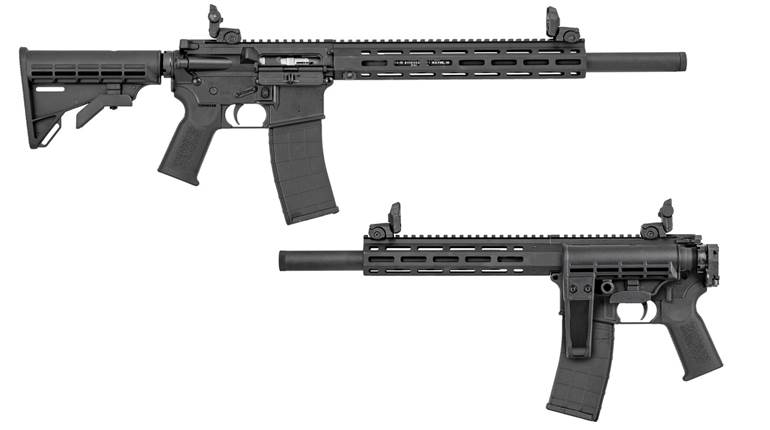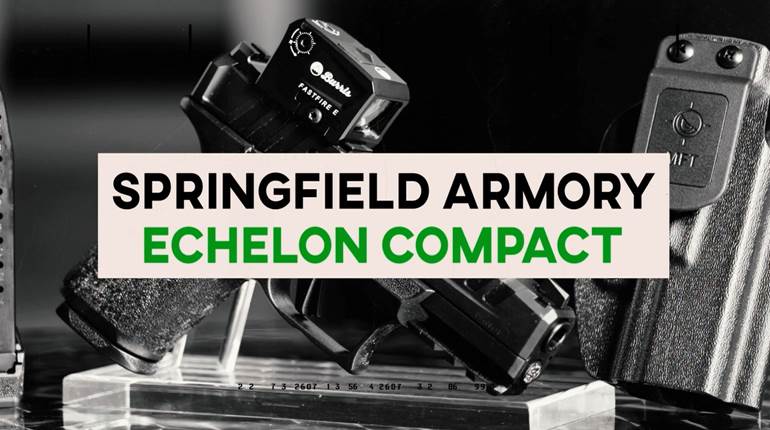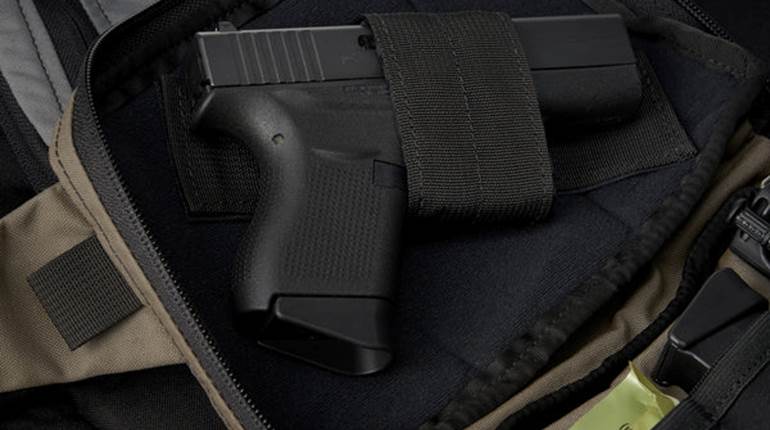
It’s a concept that dates back to the Old West when savvy cowpokes carried a carbine chambered for the same round as their revolver. Even in the 1870’s they understood the short rifle’s extra barrel length translated into extra velocity and energy. Long guns also made it much easier to hit a target and, then too, there was the convenience of having just one caliber of ammunition. Wilson Combat takes this concept a step further with the introduction of the new AR9 Carbine.
Chambered in 9 mm, these guns are specifically engineered for this cartridge. They did not simply convert an existing AR-15 into this chambering. What sets the new AR9 apart from just about every other manufacturer is the guns are made to be companions to the three most common service pistols in law enforcement: the Glock 17, Beretta 92 and the S&W M&P9. Wilson Combat has designed three different AR9 lowers to work with the magazines of these three ubiquitous cop guns.
But Wilson Combat isn’t limiting the new AR9 to law enforcement. Bill Wilson made it a personal goal to produce the absolute finest home-defense gun. From its materials, to its design and to assembly, it is clear Wilson Combat has strived to produced a gun second to none in reliability and accuracy.
The heart of the gun, or its foundation, is the lower receiver. It’s not just an AR receiver with a conversion block attached to its magazine well. Wilson Combat engineers actually had to develop three different lowers because of the difference between the Beretta, Smith & Wesson and Glock magazines. Starting with a billet of 7075 aircraft grade aluminum, Wilson Combat craftsmen machined it into a sleek lower. The magazine well opening is wonderfully blended for rapid reloads, and the magazine release pivots to release the magazine with its paddle located in the usual AR-15 location.
Unlike most other AR-style 9 mm rifles, the AR9 has a last-round hold-open feature. Wilson Combat engineers were able to achieve this by designing a finger of steel that engages the magazine follower. The bolt lock actuator is attached via a rod to the bolt lock with roll pins so the parts can never come out of time. It’s an ingenious solution to a problem most other designers overlook.

The pillar of material in front of the bolt lock is to protect the receiver and bolt lock from the pounding of the blowback action.
In examining the Wilson Combat AR9 lower I found a design feature that I wasn’t able to figure out. Situated in front of the bolt lock is a rectangular pillar of aluminum. Obviously the piece of material was purposefully left when the rest of the aluminum was machined away. Wilson Combat’s rifle department manager, Brandon Collier, explained that the extra material was to protect the bolt lock and receiver area from the harsh pounding of the blow back bolt. Remember, this is not a gas-operated gun and there is no locking mechanism so, with the goal of producing a gun capable of a lifetime of service without failure, engineers left the extra material there to protect the bolt lock and receiver.

Wilson combat engineers designed a bolt hold open device which engages the magazine follower.
The AR9 is outfitted with the excellent Tactical Trigger Unit. This non–adjustable, two-stage trigger has a pre-set pull weight of 4 lbs. with a very short and positive reset making precision shooting and rapid fire easy. My test sample actually measured at a light weight of 3.75 lbs.
The AR9’s upper receiver is also machined from billet aluminum. It has an ejection port door and a shell deflector but does not possess a forward assist. Like the lower receiver the upper is anodized and then coated with Armor-Tuff finish which gives it a rich, silky lubricious feel. A variety of colors can be requested when ordering a gun from Wilson Combat. While most manufacturers of 9 mm carbines attach a fixed ejector to the lower, Wilson Combat uses a much more subtle method and installs an ejector in the breech face of its bolt-just like a 5.56 AR-15.

Unlike most 9 mm AR-style carbines, Wilson Combat uses a spring loaded ejector in the bolt face.
My test sample has a 14.7” barrel with a Q Comp flash hider pinned and welded in place to bring its overall length to 16.” Purchasers have a choice between fluted and non-fluted barrels and my test gun is the former. While some say the fluted barrels increase the surface area, making them more rigid and requiring more rounds for them to heat up, I think their biggest attribute is their aesthetics.

No surprises here: The AR9 disassembles very much like any AR-15.
An aluminum free-floating handguard is attached to the AR9. Called the T.R.I.M. (Tactical Rail Interface, Modular) this handguard allows the user to attach pieces of rail, for accessories, at the 3, 6 and 9 o’clock positions. There are two integral push-button sling attachment points on either side of the handguard. At its top position is a piece of Picatinny rail that mates up to the upper receiver’s rail.
The AR9 comes with low-profile, spring-loaded QDS (Quick Deploy Sights). The front sight is adjustable for elevation while the rear sight is adjustable for windage. I discovered the Wilson Combat AR9 was something special when I first zeroed the iron sights.


Wilson Combat’s QDS front sight deploys with the push of a button and is adjustable for elevation; Its QDS rear sight is low profile and adjusts for windage.
With a target set out at about 30 yards I fired five rounds but could only see one hole on my Shoot-N-C target. As I walked downrange I discovered it was just one hole. All five rounds had torn a ragged hole in the target. Accuracy like this excites me.
With the iron sights zeroed I attached a Trijicon 1.25-4x scope to the carbine to test it for accuracy. Given the caliber and its intended use I thought 50 yards would probably be a good distance to test the carbine.
After firing a couple zeroing shots with the scope I fired my first group for record using Aguila 124-gr. FMJ rounds and was pleased to see a five-shot group measuring just .93.” I smiled. It’s not often that ball ammo provides the best accuracy so I knew better groups awaited me. In prior testing Ruger’s 80-gr. ARX +P ammo displayed phenomenal accuracy and it was no different through the AR9 grouping at .87” for five shots. Corbon’s +P 90-gr. JHP, Black Hill’s 115-gr. JHP EXP and Wilson Combat’s 135-gr. HBFN produced almost identically sized groups. Wilson Combat’s own +P 115-gr. TAC-XP produced a pretty little group measuring less than ¾”. But the superstar of this outing was the Hornady Critical Defense 115-gr. FTX shot into a ragged hole measuring just .41.” Never in my wildest dreams did I foresee a 9 mm carbine capable of producing sub-MOA accuracy yet the AR9 did it with room to spare.

Hornady’s Critical Defense 115-gr. FTX bullets produced this five shot, 50-yard sub MOA group.
|
AMMO |
VELOCITY |
ENERGY |
GROUP |
|
Aguila 124-gr FMJ |
1230 |
416 |
.93” |
|
Ruger 80-gr +P ARX |
1618 |
465 |
.87” |
|
Corbon +P 90-gr JHP |
1741 |
605 |
.84” |
|
Wilson Combat +P 115-gr TAC-XP |
1331 |
452 |
.74” |
|
Wilson Combat 135-gr HBFN |
1029 |
317 |
.89” |
|
Black Hills 115-gr JHP EXP |
1555 |
617 |
.85” |
|
Hornady Critical Defense 115-gr FTX |
1376 |
483 |
.41” |
Velocities were recorded with a PACT Chronograph and listed in Feet Per Second. Energies are expressed in Foot Pounds of Energy. Temperature was 105 F and humidity was 27 percent.
For field shooting I removed the Trijicon 1.25-4x scope and mounted a Trijicon RMR (Ruggedized Miniature Reflex) sight. Weighing mere ounces the red dot sight provides a brilliant aiming point even in the brightest sunlight and is completely parallax free, meaning that if the shooter can see the dot, even if it’s not centered in the sight, that’s where the round will go. I used the Trijicon RM34 base to mount it to the AR9’s Picatinny rail and it allowed me to co-witness the red dot and the iron sights in the center of the RMR’s screen. Because I had already zeroed the flip-up iron sights I merely adjusted the dot until it sat on top of the front sight as I looked through the rear sight.

Trijicon’s RMR red dot reflex sight was used for the field-shooting portion of the evaluation.
My next outing with the gun I went to a secluded spot in the Sonoran desert and set up my MGM BC-C Zone steel targets, basically the size of a standard USPSA paper target with the “D” zone removed, and was able to do head shots with the AR9 at 50 yards using the Trijicon RMR with the sights folded down. Moving up to 15 yards I wanted to see how quickly I could put two shots on the target. Hammers, double taps, controlled pairs whatever you want to call them I used one sight picture and two very quick trigger presses. My splits, or time between shots, was just 18/100ths of a second. On this outing I brought along a Glock 34 Practical/Tactical with the longer 5.3” barrel. At the same distance it took much more effort to get two hits on target and my splits averaged 24/100ths of a second. That’s the beauty of a long gun-it was almost effortless to place rounds more accurately on target and in less time. This exercise showed that the carbine was able to place two hits on target about 25 percent faster than the handgun.

For field shooting on steel targets a Trijicon RMR was used.
For those of you wondering about the velocity gained with an extra 9 1/2” of barrel it accounted for about an 11 percent increase. The increased velocity translates into about 21 percent more energy. Black Hills 115-gr. JHP ran at a sizzling 1555 fps and produced a whopping 617 foot pounds of energy. Corbon’s +P 90-gr. JHP wasn’t far behind producing 605 foot pounds of energy.

The AR9 was chronographed alongside a Glock 34 with a 5.3” barrel for comparison.
Bill Wilson might well have realized his goal of producing the finest home-defense gun available. If there is a more reliable or accurate 9 mm carbine available I am unaware of it. Whether you are a police officer or a concerned citizen the Wilson Combat AR9 should make a great companion gun to your Glock 17, Beretta 92 or Smith & Wesson M&P9. Wilson Combat also makes SBR and pistol versions of the AR9. For more information please visit wilsoncombat.com.

Wilson Combat’s AR9 makes a great companion carbine to three of the most popular police service handguns.
NRA Specifications
Manufacturer: Wilson Combat
Model: AR9
Operation: Semi-automatic, blowback operated
Caliber: 9 mm
Weight: 6 lbs. 2 oz.
Overall length: 31.25- 34.5”
Materials: Billet AR 7075 aluminum, upper and lower receivers
Barrel: 14.7” fluted with a Wilson Combat “q-comp” flashhide welded for 16” length.
Twist Rate: 1:10”
Trigger: Wilson Combat tactical trigger unit (TTU), 2-stage, 3.75 lbs. (TR-TTU-M2)
Finish: Upper and lower milspec anodizing and coated with armor-tuff finish
Handguard: Wilson combat T.R.I.M. free float handguard/rail system
Stocks: Wilson/Rogers 6-position Super Stoc, Wilson Combat/BCM starburst gunfighter grip
Sights: Low-profile folding quick deploy front (adjustable for elevation) and rear (adjustable for windage)
MSRP: $2095 for fluted barrel (as tested) or $1995 non-fluted





































